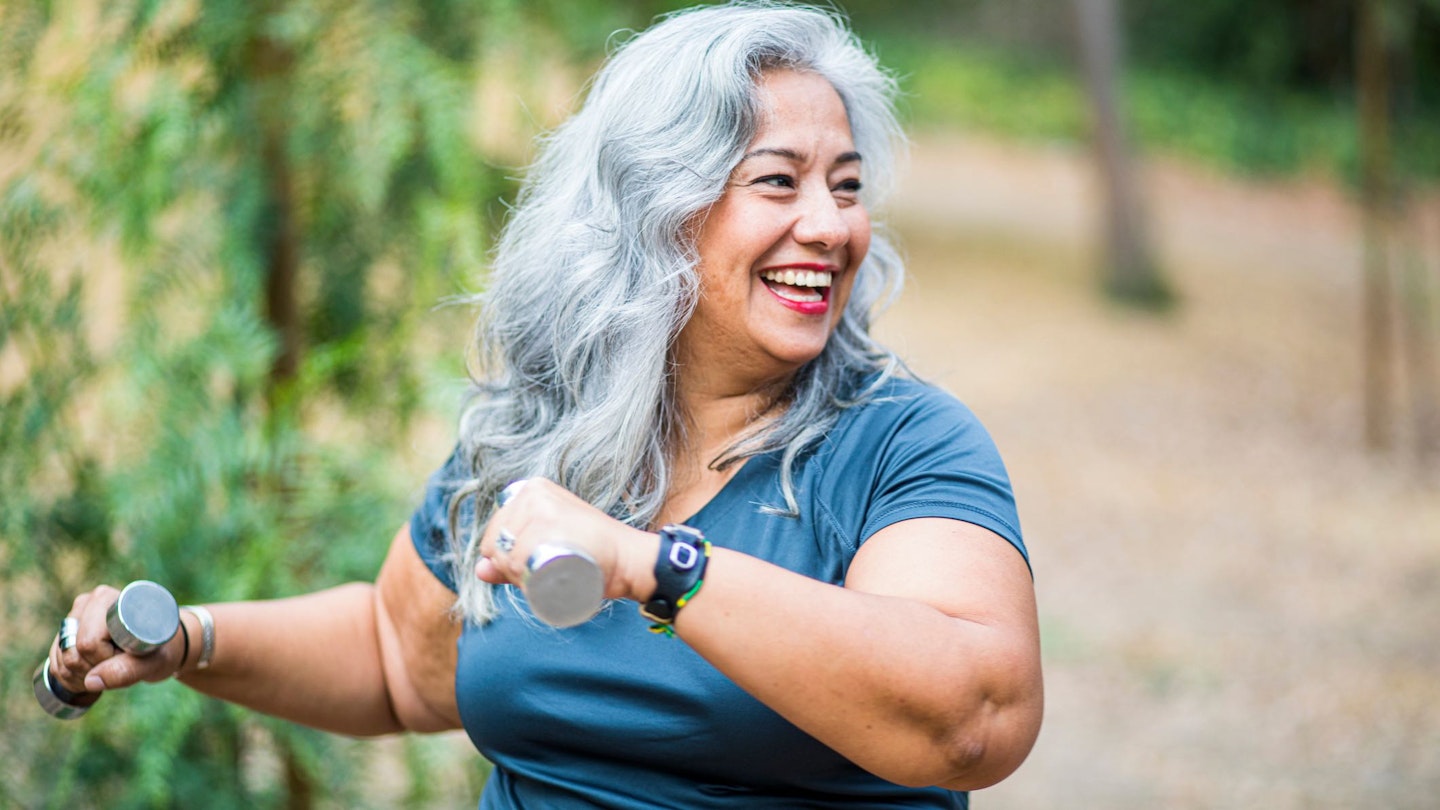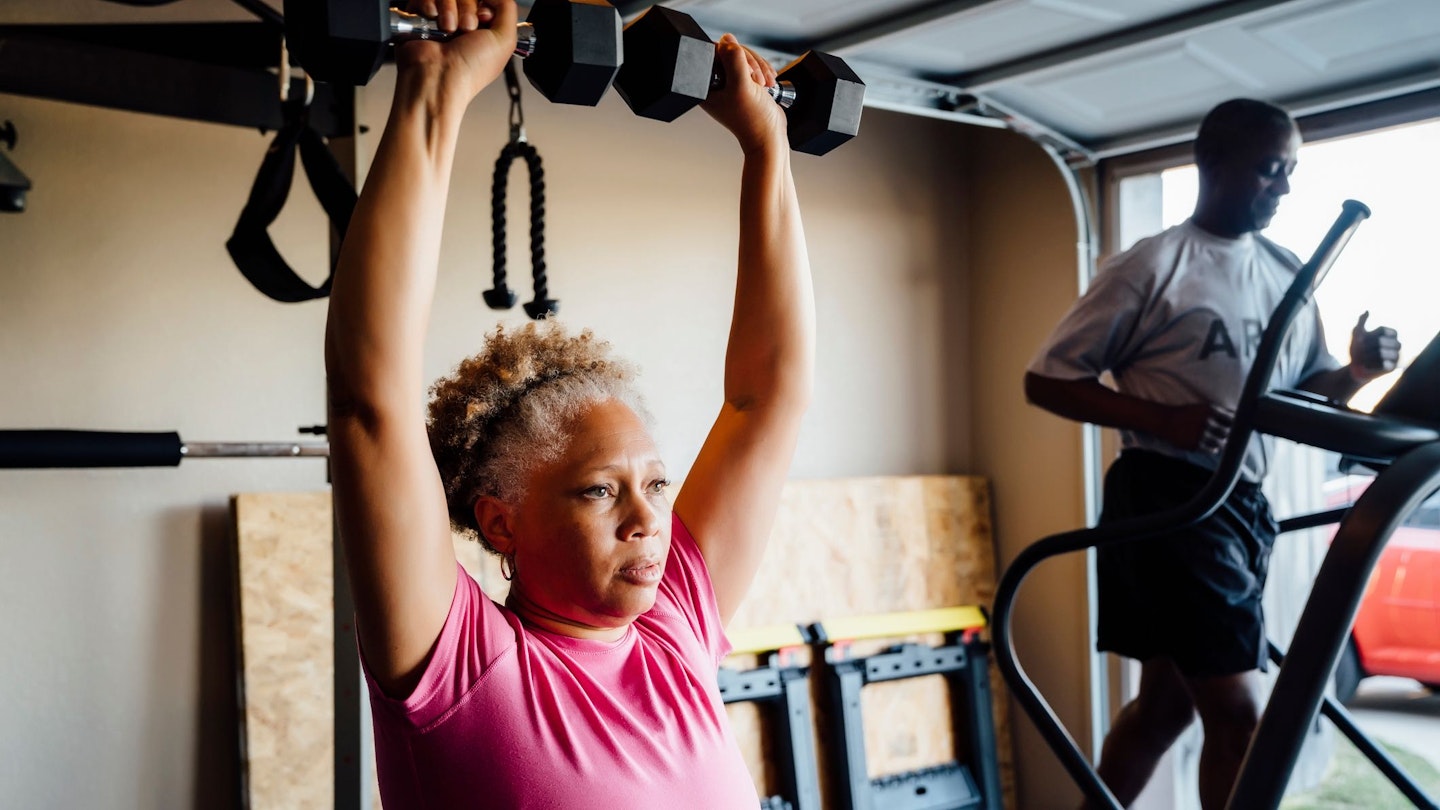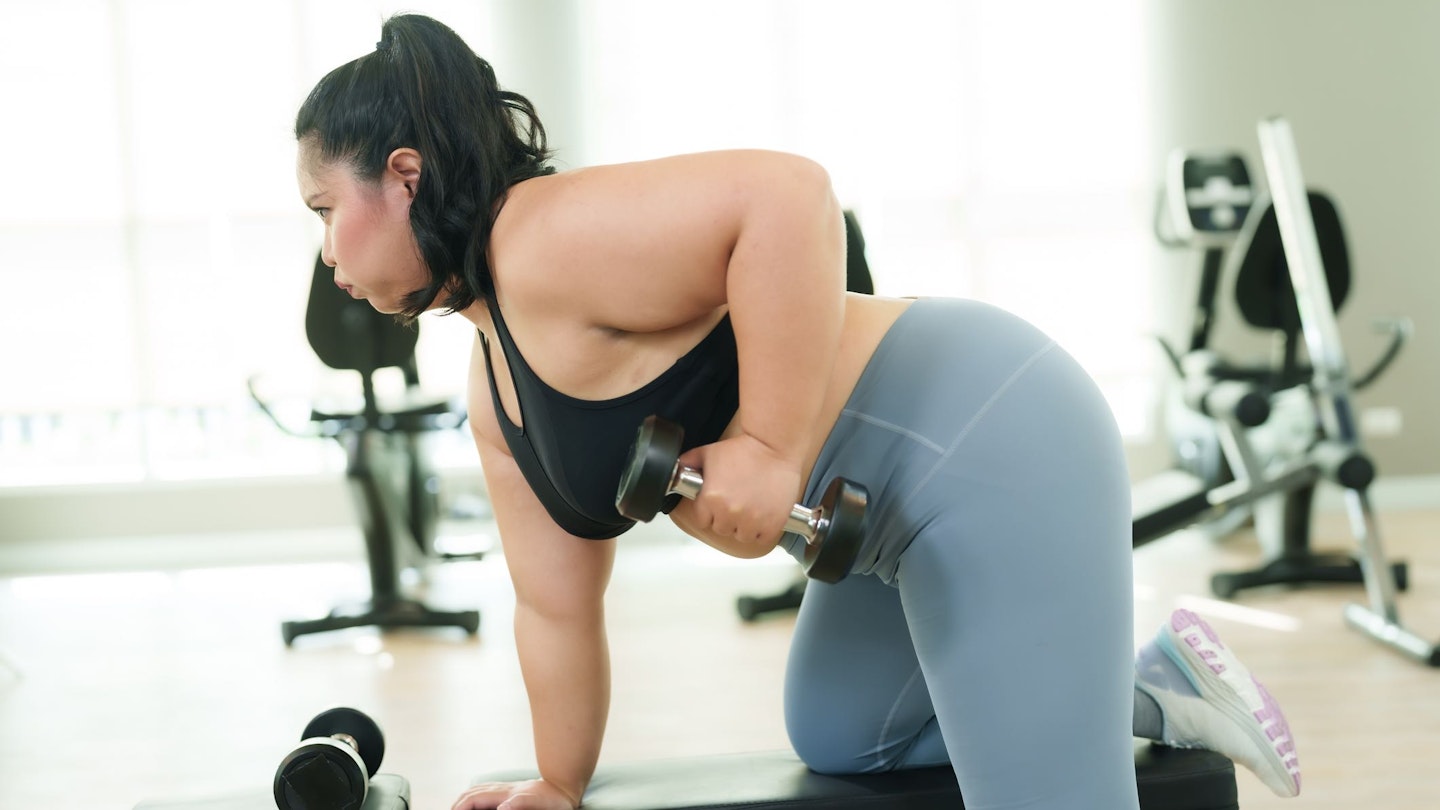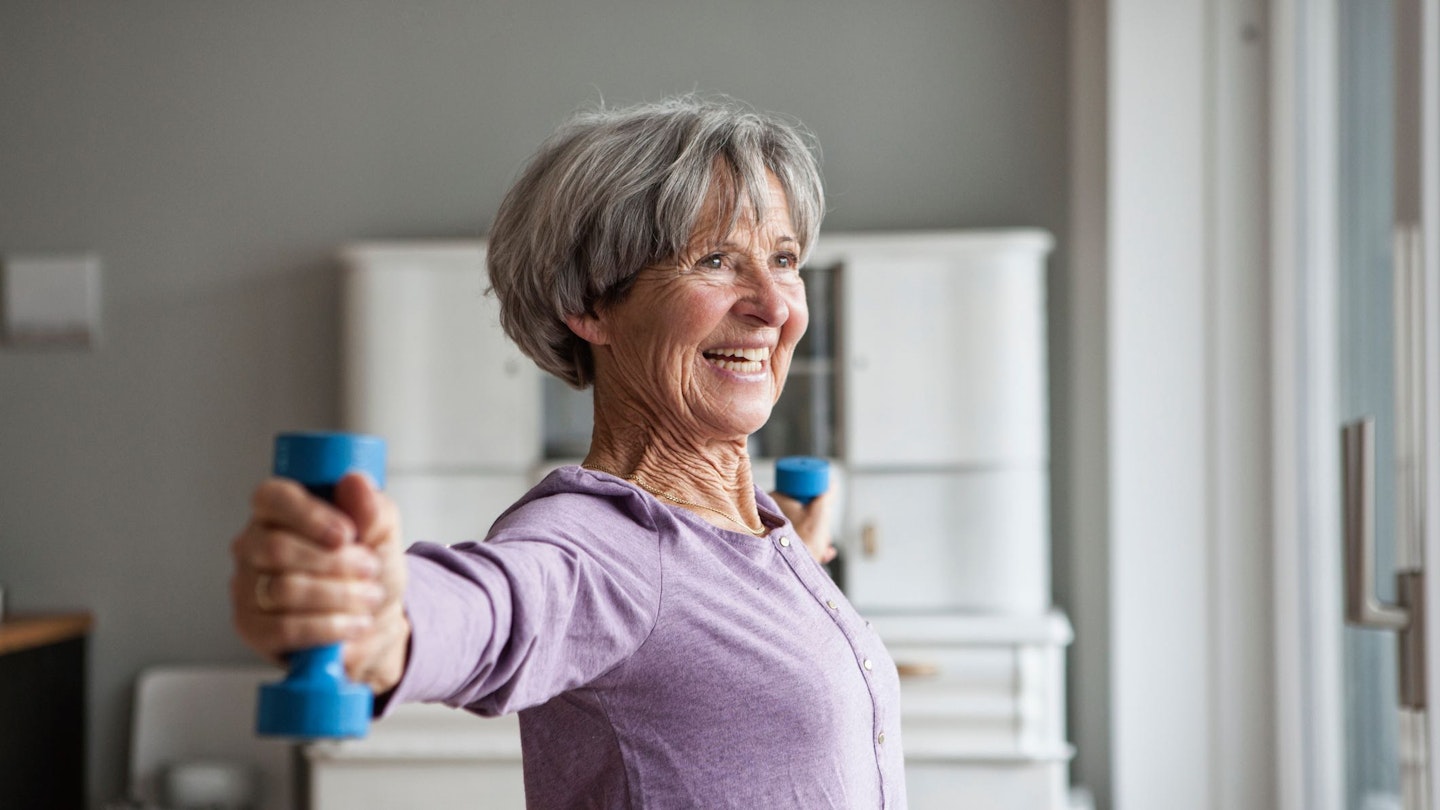Fitness trainer Joey Bull explains the benefits of dumbbells plus gives us her top 3 exercises to try at home.
Bone density and muscle mass both decrease with age, and for women, this is exacerbated during menopause. Long-term, this can lead to extra fragility; the lack of muscle mass makes us more susceptible to falls, while weakening bones can break more easily.
This sounds bleak, but it can be easily altered with some basic strength training. The NHS recommends we take part in strengthening exercise at least twice a week. This can take many forms, such as using resistance bands, doing bodyweight exercises, training in a gym, or using dumbbells.
We love dumbbells for their versatility and ease of storage, especially if you’re exercising at home. Adjustable dumbbells are slightly larger, but you only need one pair for a variety of weights. Otherwise, you could buy a set of three or five dumbbell pairs to give you a range to choose from.
We spoke to Joey Bull, Fitness Instructor for menopause platform Issviva.co.uk about how to use dumbbells, and she has also shared her top three dumbbell exercises with us for you to try out at home.

Transform your workouts with dumbbells
“If you’ve got a pair of neglected dumbbells at home, put them to use,” Bull says. “Dumbbells offer unparalleled versatility for creating impactful workouts that target various muscle groups.”
Some of the benefits of using dumbbells include:
-
Build strength – dumbbells are an easy way to build muscle strength to protect against falls.
-
Improved stability and balance – dumbbells make the body work harder to stabilise the weight, helping to improve your balance overall.
-
Improve posture - lifting weights helps improve how we walk and stand, because our core strength gets better.
-
Highlights muscle imbalance – because dumbbells require unilateral work (both sides working independently of the other), they highlight any muscle imbalance or weaknesses, so you know what to work on.
-
Relatively inexpensive – compared to a lot of workout equipment, or a gym membership, buying a set of dumbbells is a cost-effective way to exercise.
How do dumbbells help improve bone density?
“As children, osteoblasts in the body enable fast growth of bones and new tissue. As adults, osteoclasts dissolve damaged bone and tissue to allow for new growth, but it is up to us to initiate that growth by doing some form of strength training,” Bull says.
“While a little bit of walking and exercise does something, it takes good work to regain our muscle and bone density. The decline of density for bones and muscles past menopause is unfairly balanced, so focus on the importance of those dumbbells and what they can do for us.
“Aside from the risk of bone fragility, the entire body has a metabolic boost from using dumbbells. This will help improve energy levels, enable you to sleep better, and might also help you lose weight (combined with a healthy diet), reducing the risk of Type 2 diabetes.
Using dumbbells or some form of weights in your exercise will also help improve calcium levels in the blood, and help joints move more smoothly through a larger range of motion.”
Dumbbell exercises to try
Below, Joey has suggested three different dumbbell exercises to try as part of your weight training at home. Be sure to practice the movements without the weights first, so you get used to the pattern. Once you’re confident, begin by adding a light weight – you can always add more if you want to, but you don’t want to injure yourself by going too heavy.
It’s important to consult your doctor if you have any pre-existing injuries or health conditions before starting a new exercise routine.

Atlas Lifts (for full body strength)
· Setup: Stand with feet hip-distance apart, ensuring proper posture and alignment.
· Execution: First try without the dumbbells. Bend at the knees and hinge forward at the hips with a straight back, lowering the hands towards the floor.
· Action: Stand up, simultaneously straightening knees and hips while pushing the hands overhead. Rise on your toes if you can find the balance before repeating. Now pick up the dumbbells and go through the moves perfectly.
· Tip: You're working legs, buttocks, lower back and shoulder with this one. If your weights are too heavy, use one of them between two hands, pushing the weight upward and overhead, as if zipping up a jacket.
Alternative option for sore knees or hips: Chair Assisted Press
· Setup: Sit at the edge of a sturdy chair or sofa with dumbbells in hand.
· Execution: Press the weights overhead as you stand up from the chair.
· Action: Lower the weights with control as you return to a seated position.
· Focus: Slow, deliberate movements and proper posture are key to maximising effectiveness.

Robotic Pulls (for back strength and stability)
· Setup: Stand with feet shoulder-width apart, holding dumbbells in each hand.
· Execution: Hinge forward from the hips with a slight bend in the knees, maintaining a straight back.
· Action: Pull the dumbbells up towards your armpits, engaging the back muscles.
· Tip: Imagine yourself as a precise machine, executing each movement with mechanical precision. If the weights are too light, double them up into one hand and work one arm at a time.

Sculpt Your Arms with precision
· Setup: Hold a dumbbell in each hand, palms facing up.
· Action: Perform alternating bicep curls and tricep kickbacks. Curl the lower arms up, uncurl them down, then extend them behind, with the elbows high, straighten out the arm from the elbow and squeeze the arm straight.
· Focus: Emphasise the contraction of each muscle group, working steadily and deliberately.
· Bonus: Engage in conscious mind-muscle connections to enhance neurological circuits and overall stability.
How many repetitions should I do?
Bull says: “How heavy the weights are, and your level of fitness will dictate this, it may mean 5 to 25 repetitions. Either way, challenge yourself to push past discomfort and strive for two more reps when you think you've reached your limit. Every repetition is a step towards your goals, propelling you towards a stronger, healthier you.”
How often should I use dumbbells?
As a guide, aim for a minimum of two strengthening sessions per week. That might be the exercises above, or it might be something different. Two sessions are the minimum, so feel free to do more if you wish to. It’s important to allow your body time to rest in between sessions though, so make sure your space them apart.
A final word from Joey Bull
“With dedication and perseverance, these exercises will lay the foundation for a transformative fitness journey. Ignite your inner strength and unleash your full potential with the humble yet mighty dumbbell! They last for a lifetime too. Your body will thank you for the investment in its future well-being.”
Joey Bull is a fitness Instructor for menopause platform issviva.co.uk and champions women age 45+
Becky Fuller is a senior digital writer for Yours.co.uk. She is also a fully qualified personal trainer and strength coach, specialising in fitness and wellbeing for over 50s. Prior to joining Yours, Becky was a fitness writer for Saga, and a freelance entertainment and theatre journalist. Becky is passionate about helping people to move well and discover the many benefits of strength training.
